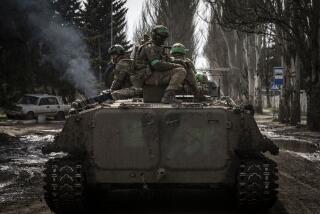Army Figures It Can Outsmart the Enemy With Fake Tanks, Plastic Soldiers--Really
- Share via
BELTSVILLE, Md. — The U.S. Army, returning to an age-old strategy used extensively by the Soviet military, is increasing its use of decoys and fake targets in hopes of outsmarting an enemy’s modern weapons.
Decoys ranging from canvas tanks to plastic soldiers could make the Army in battle seem twice as big as it really is. And, if that news seems to give away the secret, the Army points out that the enemy still doesn’t know which half is real.
“We will always be outnumbered conventionally. These (decoys) are a force multiplier,” said Stephen P. Rosa, vice president of TVI Corp., which developed fakes, such as a M-1 tank and trucks.
Look Real to Naked Eye
The canvas, two- and three-dimensional tanks made at TVI’s 50-worker plant outside Washington look real both to the naked eye and to heat-seeking thermal targeting systems used at night.
An unassembled front-view M-1 weighs about 25 pounds and collapses into a 4-foot by 2-foot duffle bag. In less than three minutes, one man can assemble it and plug in a generator to warm up its thermal “signature.” With a tape recorder and speakers, a pair of soldiers can sound like an entire tank battalion.
A fake M-1 costs about $3,500, compared to about $3 million for a new M-1.
“Deception really is the second goal. Survivability is the first,” said Rosa. “Decoys are credible targets . . . they allow the real vehicles to move around” and increase the survival rate in battle.
The Army has about 4,000 real M-1 tanks and plans to outfit each with at least one fake M-1, at a cost of about $7.5 million, said Maj. Andrew Fallon, of the Army’s budget office.
Deception has been a key element in military strategy since the Trojan Horse. German Gen. Erwin Rommel fooled Allied forces in North Africa during World War II, the British fooled the Germans and the Israeli Army today regularly uses deceptive false radio chatter.
Soviets Most Adept
But the Soviets are thought to be the most adept, having everything from pseudo ballistic missiles to entire fake armies under a branch of the military called the Principal Directorate of Strategic Deception.
“We know they make decoys of the highest order of equipment, even as much as making fake missile silos,” Rosa said.
Fallon said the Navy is working on decoy ships and the Air Force has ground decoys of F-16 fighter jets that can turn a bare airstrip into a fake air base.
The decoys are made from blown-up photographs of the real things. They look remarkably real at a glance, which in battle is all an enemy would get before deciding whether to fire, Rosa said.
The canvas used for the tanks, jets and trucks is lined with a thin plastic film first developed at TVI as a heating element for ceiling panels, said Alex DeFonso, a founder and vice president of TVI.
Soldiers Are Fooled
By mixing the concentration of the plastic sheets, designers can create thermal images of a vehicle’s wheels, engines and armor. The thermal and visual images are so realistic that even soldiers in exercises were fooled.
“You may have the knowledge they are there, but it becomes impossible to discern if (the tanks) are real or fake,” Fallon said.
The tanks can even survive one or two hits, which go right through without knocking the decoys down. “The enemy doesn’t see a flash and he thinks he missed,” DeFonso said.
The Army continues to develop more elaborate decoys, including electronically generated fake targets, that do not involve props in the battlefield, Rosa said.
More to Read
Sign up for Essential California
The most important California stories and recommendations in your inbox every morning.
You may occasionally receive promotional content from the Los Angeles Times.










